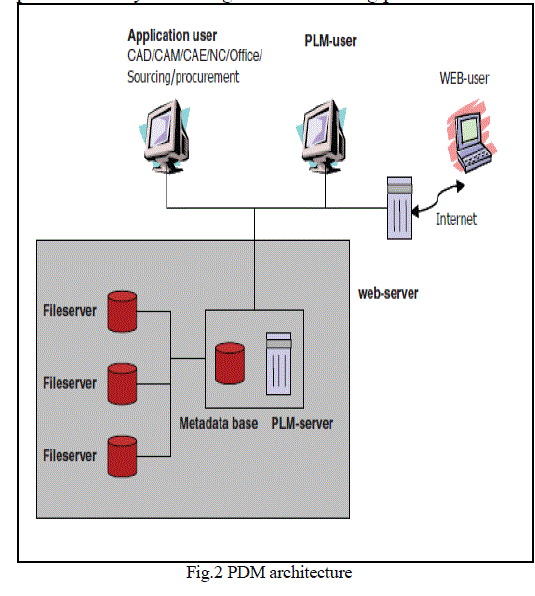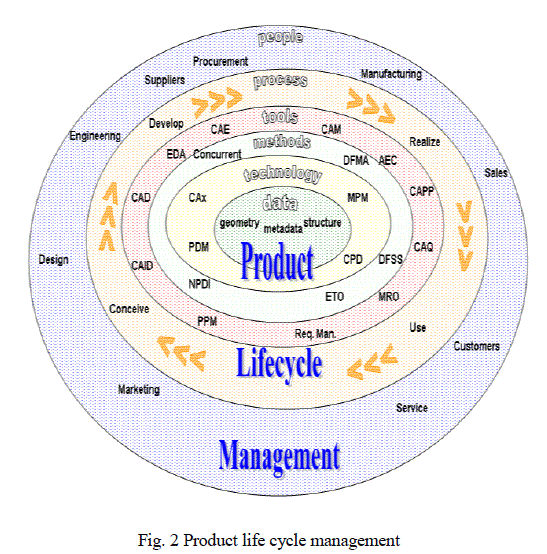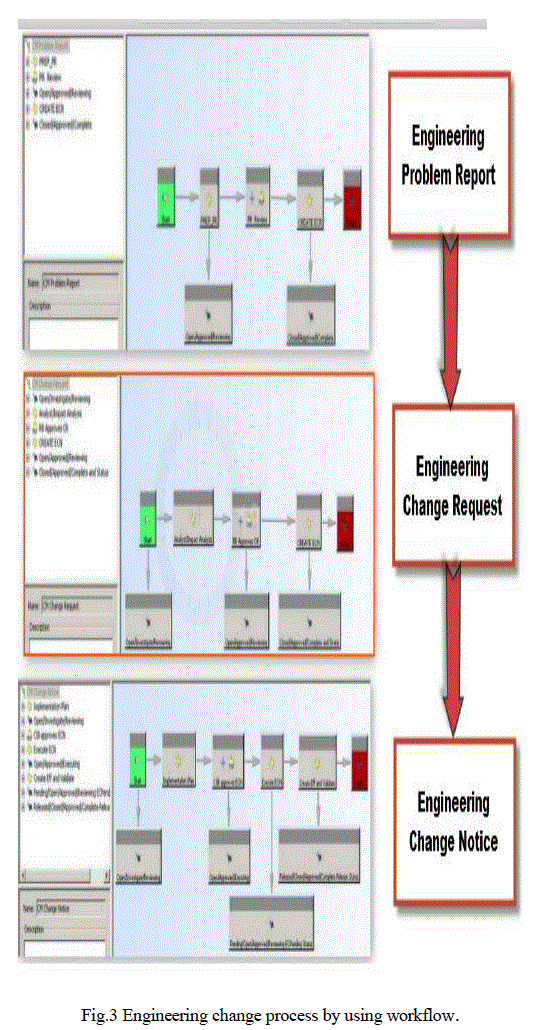ISSN ONLINE(2319-8753)PRINT(2347-6710)
ISSN ONLINE(2319-8753)PRINT(2347-6710)
Keshav N. Sakhare, Dr. Balaji M.Dabade, Aniket Kadu
|
| Related article at Pubmed, Scholar Google |
Visit for more related articles at International Journal of Innovative Research in Science, Engineering and Technology
To design a new product is a challenging task in any company. The company was operating in a highly networked environment. In addition to its own design organization, some external parties were very deeply involved. The subcontractors and partners in various areas, the auditor and the customer are important from both the definition and execution point of view of the design. The development of complex products, such as automobiles, involves engineering changes that frequently require redesigning or altering the products. Although it has been found that efficient management of knowledge and collaboration in engineering changes is crucial for the success of new product development, it is far more difficult than it seems.PLM as we know is a philosophy to control and manage the data flows in a company. As the complexity of the processes go on increasing, managing the data flows becomes complex. Hence it is important to manage these flows through change management processes. The change management tool with workflows would be used so that the subcontractors, the auditor, the customer and the company’s own production could be connected to the design with the assistance of the product lifecycle management system. The paper describes the product life cycle management fundamental, product data management system, organization, product structure, workflow management and related other process. How change management process can be simplified by using custom workflow process.
Keywords |
| Teamcenter, Change Management, PLM, workflow |
INTRODUCTION |
| A workflow process is an automation of business procedure in which documentation, information or tasks are passed from one user to another in this way it is governed by rules during completion of particular process. Workflow is some time called as a series of task that produce an output. Workflow can be used to manage a common business process within an organization. In case of change management company was working in highly networked environment in addition to its own design organization ,some external parties were very deeply involved it contains subcontractors, partners in various area and customers are important from both the definition and execution point of view of the design .the change management tool with workflow would be used because subcontractors, the customer ,auditor and the company’s own production department could be connected to the design department. With the use of product life cycle management system, the auditor and customer could electronically deal with the compulsory approvals and inspection of the design and design changes in preparation. The change management tool is used to gain the significant advantages especially regarding turnkey (complete and ready to be used) deliveries by using the internet user interface to the PLM system. Due to the use of change management tool we could reduce cost caused due to the bad flow of information and uncontrolled change. The same PLM application or software used by the parent company could be used by the subcontractor, by the customer and by the auditor. Management of such kind of unity or totality could be carried out using the standard workflow features of the PLM system. The auditor or customer is defined in the workflow as a one parties to accept the information or the document before the parent or principal design subcontractor could release the document. Such that it is used in companies and subcontractors more effectively than the before, production should know the how delivered to the design and engineering through a request for comment, for example internal and external manufacturing parties. |
II. PRODUCT DATA MANAGEMENT (PDM) |
| Product data management is the subset of product life cycle management and configuration management. product data management is the tool used to track and control data related to a particular product, the data tracked usually contain the technical specification of the product ,mainly specification for manufacturing and development and the type of material which required by the product. In PDM the focus is mainly on the managing and tracking the change, creation and archive of all information related to the product, the information being stored and managed will contain the computer aided design (CAD) model, drawing and their related document. The central database also manages the metadata such as owner of the file and the release status of the component. The package will control the check-in and check-out of the product data and multi user .This allow in automatic report on product cost. Product data management helps the companies for producing complex product to provide the product data in to the entire product life cycle management launching process. |
 |
| Product data management is focused on capturing and maintaining information on product and service through its development and its useful life. The basic function of the PDM:- • Secure storage of the document and other object in a database with controlled access. • Component of supplier management. • Management of temporal evolution of an object through sequential revision. • Management of alternate variant of an object. • Management of the change that affect multiple related |
| Management of the inspection and release procedure associated with the objects. • Management of multiple views of an object. • Management of multiple document representations. |
III. PRODUCT LIFE CYCLE MANAGEMENT |
| Product life cycle management (PLM) is a, controlled concept for managing and developing product and product related information. The core of the product life cycle management is the creation, preservation and storage of information relating to the company’s products and activities, in order to ensure the fast, easy and trouble-free finding, refining, distribution and reutilization of the data required for daily operations. PLM integrate people, data, process and business system and provides a product information backbone for companies and their extended enterprise. |
 |
| The product lifecycle management concept, at its simplest, is a general plan for practical product lifecycle management in daily business at the corporate level, in a particular business or product area. It is a compilation of business rules, methods, processes, and guidelines as well as instructions on how to apply the rules in practice. Usually, the product lifecycle management concept covers at least the following areas: 1. Terms and abbreviations used in this field. 2. Product information models and product models. Definition of products and product-related information objects (items, structures, product-related documents, definition of product information, etc.) 3. Definition of products and product-related information objects. 4. Product lifecycle management practices and principles used and applied in the company. 5. Product management related processes 6. Instructions on how to apply the concept in everyday business |
IV. ORGANIZATION FOR WORKFLOW |
| The organization application allows creating and maintaining a company’s organization. This organization is way of organizing user account and their respective permissions and the user group. The user account helps us in: • Track changes of objects. • Control access and privileges. • Manage default object ownership. |
V. TYPICAL BUSINESS CASE |
| Figure below shows the Product structure of universal joint.Problem in one of the part seen at manufacturing department. |
 |
VI. WORKFLOW MODELING TECHNOLOGY |
| The term workflow is define as the automation of business process in the course of which document, information or task move from one participant to another in order to perform some action in accordance with a set of procedural rules.Teamcenter integrates the workflow system and design systems to provide functionality for collaborative product development such systems which enable automated product design can increase the efficiency of design activities. The term workflow management refers to the ideas, methods, techniques, and software used to support structured business processes. The objective of workflow management is to achieve streamlined and easy-tomaintain work processesWorkflow management systems are designed to support business processes. A business process consists of a number of steps (activities) that can be executed automatically, manually, or using a combination of these two. A workflow management system does not only support the execution of activities, but also takes care of the distribution and assignment of work items to employees, and provides the possibility to keep track of cases and to gain statistics (for instance management information) of the process and the workers. In this paper the workflow driven flow process are exposed through which all activities of change management for product development. Workflow can be explained as in the enterprise the design team perform the conceptual and detail design after a study of drawing and specification. The 3D modeler will create the 3D model of the product. The analysts do analysis on that 3D model and analyze the cause of failure of product. After analyzing the CAD model is submitted to the workflow process to get the regularly reviewreport from the other department, customer and vendor of the organization. A workflow template is consisting of many task, the task is created by applying the transition rule which is controlled by the handlers related with the task. A CAD file, massage, analysis report, and other related document are included in the task for delivering the information when the workflow is executing. In this case of change management the task is arranged are: Engineering problem report, Engineering change request and Engineering change notice (see fig.3). Engineering problem report stage is refers for the activity analyst perform the some task such as determine problem mentioned in the problem report is it real and it require a review or not , assign change specialist and change analyst, creation of engineering change request and submitted to the next stage of the change management. Next stage is the engineering change request where assigning change specialist II, change analyst for ECR, performing impact analysis, relate impacted item to the ECR(impacted item folder), create a plan or schedule the activity and relate to the ECR, review the ECR, create the ECN (Engineering change notice) and submit it to the ECN workflow. In engineering change notice stage the create the detail plain to execute the change, also make sure that impacted item is related or not, send ECN to the change manager and review the impacted item, make changes in product structure, create effectivity. The entire task of the change management is integrated and automated by the implementation of the workflow technology. All the participant in the organization are considered in the workflow template as per their role and the order of the task, as the participant complete the assigned task to them then the workflow template will indicate the green color and if participant reject or unable to give required document it indicate the red color otherwise it appears gray. The participant those who are not the member of the change management process and want to see the status of the object they can check by using workflow viewer. |
ADVANTAGES/CONCLUSION |
| • Workflow technology implementation for the change management activity reduces the development time and achieves the collaborative and concurrent environment. • It is used during the introduction of a new part or new product in market andreplacement of an old part with newly developed part according to customer requirement. • To elimination of errors on a document and bringing an old document up-to-date. • Only authorized users are allowed to perform the task and taking decision of approval or rejection, to increase the data security. • Workflow technology implementation for the change management allows you to improve your product faster than your competitor. |
| Integration of change management with the workflow management also helps in integrating the suppliers, allied partners and customer through service center in to your change process. • Development of the design those are not possible to manufacture may get eliminated due to the intermediate reviews from the manufacturing department, which may help to produce the designs first time correct. • This technology is helpful in eliminating the mistake in document and manual transferring the document to the next department. • It is used during the introduction of a new part or new product in market andreplacement of an old part with newly developed part according to customer requirement. |
References |
|